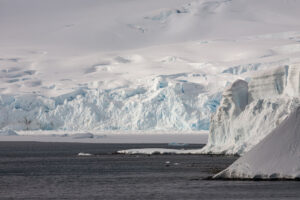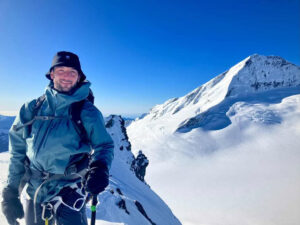On Jan. 11, Vincent Colliard broke the Hercules Inlet to South Pole speed record in Antarctica. This was not low-hanging fruit. Christian Eide’s 2011 time of 24 days, 1 hour, and 13 minutes, was exceptional.
A handful of hopefuls had tried to best Eide in the last decade-plus, but none came particularly close. Colliard not only trimmed the time, he knocked almost two days off it, finishing in 22 days, 6 hours, and 8 minutes.
Now back in Oslo, Norway, Colliard spoke to us about the record, his time on the ice, and his future plans.
This interview has been edited for brevity and clarity.
First of all, congratulations on the speed record. How are you feeling?
I’m feeling good, still a little bit confused, trying to process everything that has happened. I was still in the tent just over 10 days ago and now I’m here in comfort. A big change but I’m very, very stoked.
I feel fine. Mentally I am very good because I’m pleased that it somehow worked out. But physically I still have the impression that I’ve been in a race, that my body needs to recover. When I go up and down the stairs it feels strange on the hips, the knees, the feet.
But I do hope to be back skiing as soon as possible. I want to keep an active lifestyle and don’t want to miss too many great winter days here [in Oslo]. It might sound weird to go back to skiing, but it is my favorite sport, it’s a lifestyle.

Photo: Vincent Colliard
Staying slightly cold
How did you structure your days on the ice? Did you sleep most of the “day” and travel at night when it was colder and, in theory, the snow was firmer?
No, I stayed on Chilean time. I stayed on the same time as Antarctic Logistics & Expeditions (ALE).
I was skiing on average 12 hours per day, fluctuating between 11 and 13 hours. From 9 am, I was on skis until 9 or 10 pm. I took as short breaks as possible and tried to stay slightly cold the whole time. I was making sure that my body temperature was always ready to go, ready to keep moving.
Did you keep track of your cadence/strides per minute while skiing? Or were you just tracking the hours you were putting in?
I was just tracking the kilometers. My goal was to make sure that I could go above 50km in less than 12 hours. I knew that Christian’s daily average was 47km for the length of the expedition.
I thought I had to go over 50km. I didn’t manage to do this at the beginning. I had some powder and some whiteouts. It was only on day nine that I managed to break 50km. I knew I had to respect my sleeping time, so I had to make sure I could do 50km in 12 hours. That was my base for skiing.
Christain Eide averaged 47km but he finished on a pretty massive closing kick, completing 90km or so on his final day. Did you have that in mind?
Yes, absolutely. I wrote Christian’s kilometers on the inside of my tent and wrote all my days on the other side so I could compare. I knew that he had such an amazing day at the end. On my side, I was unsure that I could do such a long day so my game plan was to try and build consistency every day. I tried to do just a little bit more than him, to accumulate, to get a buffer.

Photo: Vincent Colliard
Did you find knowing exactly what Christian had done, day in and day out, to be an advantage or a hindrance? Did you feel pressure?
In the beginning, it was for sure pressure. I was like, man, the standard is high. That’s what I told Christian two days ago when we met in Oslo. I told him it was probably easier for me, it was a big challenge, lots of pain, but in the end probably easier. Because Christian didn’t have anyone to beat, no one in front, just himself.
But it’s a question mark in my head. Isn’t it easier to break a record than to establish it? I think it is easier to break it.
Seven spills in a day
What skins did you use and how did you manage your sled? I recall you were putting them in a catamaran setup for some sections for stability.
In the first half of the journey, I had various days with whiteouts and sastrugi. Even though the sastrugi were not very big, they were big enough to capsize my sled. One day I capsized seven times.
I thought, this is not good, I’m losing time and energy. So I put the sleds together as a catamaran. It’s much more friction but I can at least relax and go straight without worrying about them tipping over. I had to do it for three days but it worked.
For skins, most of the way I used 30mm skins. I only had to use wider skins on day one, just for the first climb. I never used long skins, I didn’t even bring them with me.

Photo: Vincent Colliard
In terms of gear, you were traveling incredibly light. Did this mean you had to worry about damaging or breaking equipment?
Good question. I changed my mindset, whether it was with my tent, my sledbag, or with every zipper on my clothing, I felt that everything was so fragile. I had to modify the way I used my gear, being extra careful.
As soon as the weather was a little bit tougher, I told myself: “If you feel the need to speed up, just try to slow down. Do the opposite of what you usually do.”
Every time I felt I was going too quick or too strong on the equipment, I’d stop the process, have a drink, and think. Think about what would happen if I break something. I’d be in trouble or at least lose a lot of time.
I wouldn’t do it again with super-light equipment. I’d take a little more weight and relax a bit because it is difficult to be very careful when you’re very tired.
Coming close to pulling the plug
With the weather and snow conditions, do you know how your run compares to average years or Christian’s run? Were you lucky, unlucky?
First of all, it’s my first full-length expedition in Antarctica. I’ve guided there on the peninsula and on two last-degree trips, but I don’t have tons of experience. But if you compare it with the Arctic Ocean, I think the terrain in Antarctica is quite easy. I’m not one to be dramatic, I thought the terrain was OK.
I think the weather this year might have been a little more challenging than Christian’s year, but we’d have to fact-check with him. I had more than three degrees with powder.
When I got past the Thiels mountains, when I was close to 86°, I told Lars Ebbesen [polar guide who attempted the speed record in 2018] that if the weather continues like this, with powder and whiteouts, I might pull the plug. Two times I was on the edge of pulling the plug. I was still putting in the kilometers but was close to mentally breaking down. I just thought I couldn’t keep doing 50km in those conditions.
But things improved and at Thiels [Corner], I got rid of five days of food and later I got rid of two more days. I didn’t want to just reach the Pole, I had to take the risk to be lighter.

Snow conditions weren’t always ideal. Photo: Vincent Colliard
If the worst moment was at Thiels Corner, what was the best?
I think the best was at 83°. It was probably better than seeing the Pole. I had my first day of good weather, a hard surface, and no wind. It was the first day I managed to ski 53km and it was the only day of the expedition that felt like I was skiing rather than walking.
You improved Christian’s record by almost two days. I’d be interested to know what time you think could be possible for the route. Were you near your max or do you think you could conceivably go faster than your 50km+ per day average?
No, I don’t think it is the limit. I now have the answer that my body did the job, and I think it is possible to do better. With a harder surface and less powder, it should be possible to improve the time.
Other challengers
Do you see anyone else trying it considering you’ve made a hard record even harder?
Yeah, I know there is a guy here in Norway who might try. People will try. Especially because there are few firsts left in the polar regions. There are still some [firsts left] but they are so expensive. So I think people will go back to Antarctica and try to break the record.

Photo: Vincent Colliard
If someone can break it, presumably, it will be an Olympic cross-country skier or similar.
This is exactly what I thought. I hope I stay humble because I know that if a professional cross-country skier takes an interest in pitching a tent and starting a stove, then they’re going to do a lot of damage!
Finally, do you have any plans for what is next? A couple of years ago you were planning to go to the North Pole before the Barneo season was cancelled.
Yes, North Pole is still in my head, but not for now. I spent too much money and energy on this project. I might go back to the Arctic Ocean if everything there is stable.
For now, the beautiful thing is Caroline [Cote, Colliard’s partner] is pregnant so we’ll be spending family time next season. But I think we’ll get back to Antarctica, not next season but maybe the season after, even if it’s to do a season at ALE. The people at Union Glacier have been so supportive that we’d love to do a season down there.






